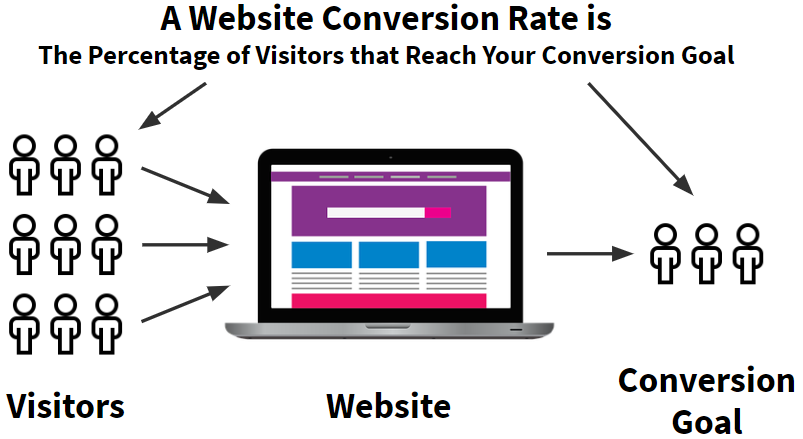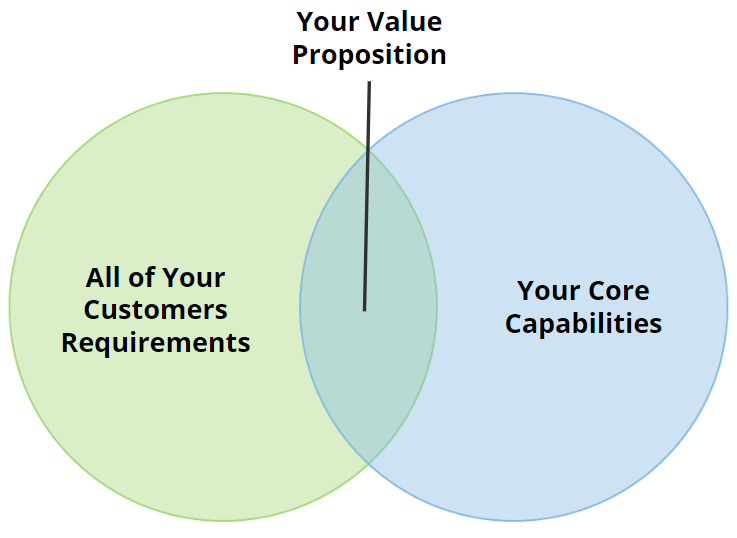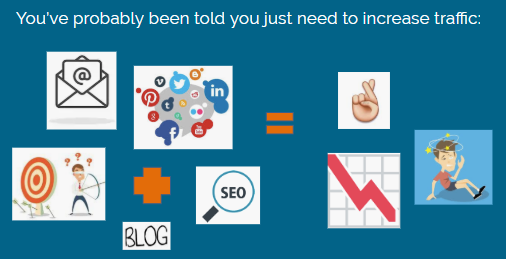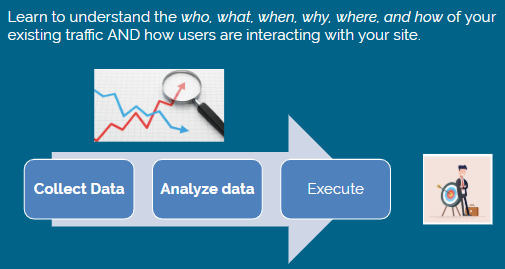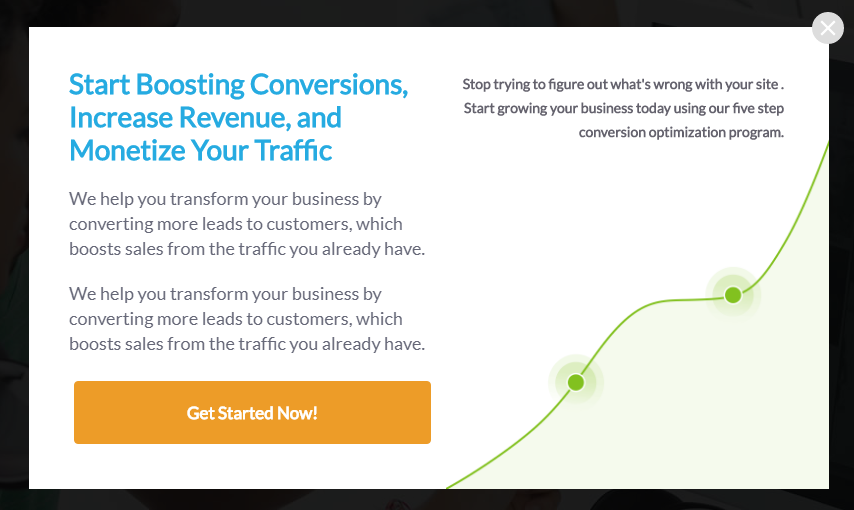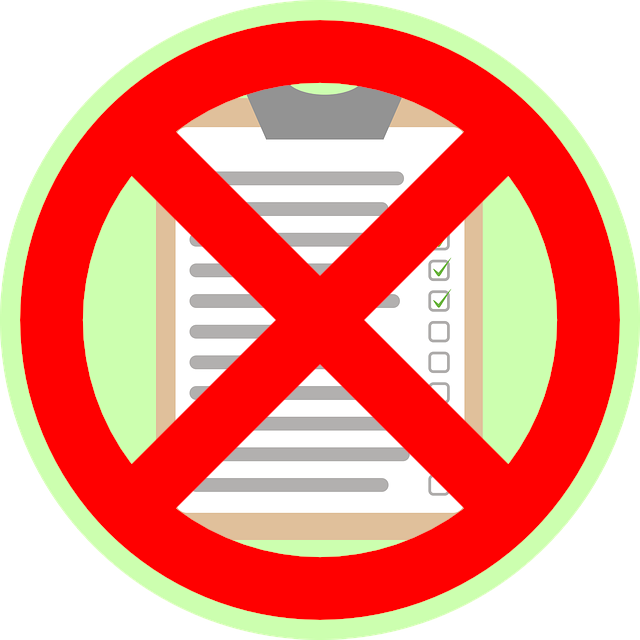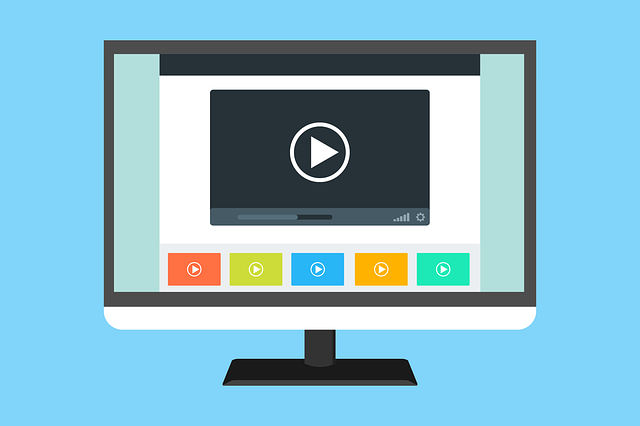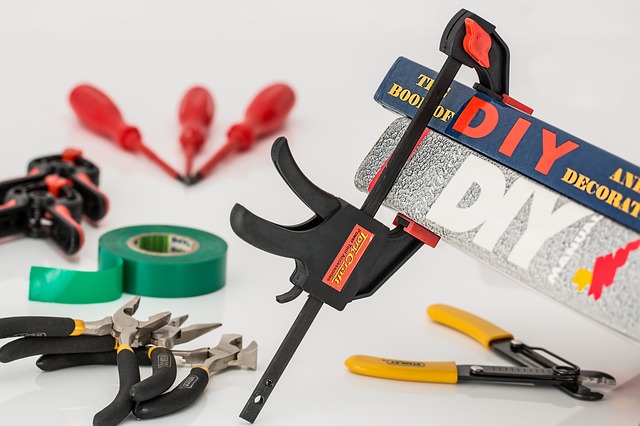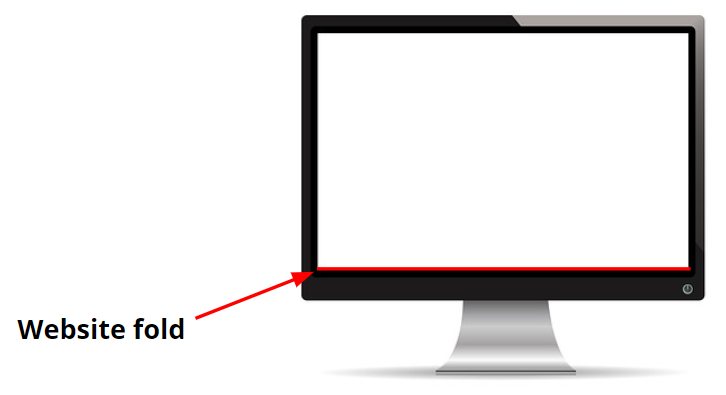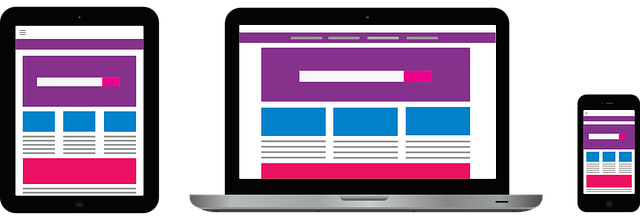The greatest website Conversion Rate Optimization (CRO) myth we've seen is that you can download and apply some checklist, and expect your site conversion rate to skyrocket. Nothing could be further from the truth. Increasing website conversions takes a holistic data-driven approach, not 100 band-aids. This is exactly why only about 22% of businesses are satisfied with their conversion rates. (Econsultancy, 2016)
Per the book Making Websites Win, Proper CRO techniques work on any website, regardless company size, type of business, industry, and product type.
In this article, we'll describe common conversion problems, bust myths, and explain how to maximize conversion rates.

Why you Need to Improve your Website Conversion Rate
Improving your conversion rate means adding more new customers without having to spend a dime more on advertising, or any other part of your funnel, and without needing to increase traffic.
Your revenue is equal to:
- The number of visitors multiplied by
- The conversion rate (percentage of visitors that turn into customers) multiplied by
- The average lifetime spend of each customer.
Thus if you double your conversion rate, you double your revenue.
Example
100 visitors x .01 (1% conversion rate) x $100 = $100
100 visitors x .02 (2% conversion rate) x $100 = $200
Problems and Symptoms of Poor Website Conversion Rates
Before we get to the myths, it's a good idea to review where you're likely at today. This article is for you if you're part of the 78% of business owners that are dissatisfied with your current conversion rate.
If that's you, you’re wasting time, money, and other resources trying to fix the issue yourself, spinning your wheels, and guessing. If you're nodding your head, keep reading.
For every $92 spent acquiring customers, only $1 is spent converting them. (Econsultancy, 2016)
Let that number sink in for a second because it's backwards unless you're website is converting at satisfactory rate. In other words, it's imperative to address your conversion rate first. Most likely the reason you're in this boat is simple: you're neither a designer, nor a data analyst, nor a developer, nor a content copywriter. Yet all these skills are required to maximize conversions.
A quick back-of-the-envelope calculation shows why this is bad: suppose your website's conversion rate is 1% and you're getting 100 leads per month from your existing efforts. If you want to double your conversions, you'll need 200 leads a month, you'll need to double your ad spend, write twice as much content, and so on.
However, if you merely increase your conversion rate 1%, you have achieved the exact same result! In other words, as we said above, if you double your conversion rate, you double your revenue without wasting a bunch of time and money.
Now let's look at the problems and symptoms of poor conversions.
1. You’re Focused on the Design and Not Outcomes
- 95% of visitors will engage more with a website that has good user experience
- 80% of small B2B business websites lacked a clear call-to-action
As a business owner, you don’t have time to dedicate to diagnosing your website performance. Yet nobody is doing it for you, so you’ll continue to spend resources and get little to no returns from your investments.
Because you're not an expert, you’ll be stuck, and have less time to focus on your business. Even worse, you'll be up all night wondering why such a great looking website isn’t converting the way you think it should. The most beautiful modern design in the world won’t do a thing to improve conversions by itself in most cases.
If you aren’t able to clearly communicate your business value and provide an easy path for your customers to do business with you, you’ll be missing out on revenue that should be yours.
What are the biggest pain points your target visitors are experiencing, and how does your solution help them? If you’re not crystal clear on the value you're providing, you’re missing opportunities to gain new customers/clients. You need messaging that conveys your unique selling proposition.
2. Visitors Never get the Chance to Convert or Aren't Sure if they Want to do Business with You
Often times we'll review sites, and we scratch our head wondering what's the best way to schedule an appointment or book a call. Perhaps there's just a link to the contact page, but no reason is given to go there. Your site should have clear primary and secondary calls to action. But calls to action are just a micro piece to a much larger conversion rate puzzle.
Suppose you buy a new spiffy-looking premium theme and have a developer apply it. Suppose you're using a Do It Yourself (DIY) website product and you select one of the tens to hundreds of themes available.
A pretty new theme can still have several conversion blockers, including:
- Lack of focus on outcomes for your customers.
- Confusing navigation and/or user interface.
- Confusing or lack of a clear call to action.
- Design doesn’t work across devices & browsers.
- Site is too slow and/or insecure.
Addressing conversion blockers is an important ingredient in the conversion rate boost recipe. Your visitors will engage more, find your website easy to use, and most importantly, do more business with you. They’ll also not hesitate to refer your website to their friends and family for business.
3. Your Website Visitors are Bouncing, and You don’t know Why
There are four primary reasons people bounce from a website:
- It's too slow or has technical issues
- The visitor experience is poor
- The messaging/marketing content is confusing
- The aesthetics are displeasing.
It's extremely frustrating to have high bounce rates on key pages. You don’t know why people are bouncing, or what you can do to prevent it. You research reasons why people bounce from websites, get a checklist, and are surprised when it doesn’t make that much of an impact (or even worse, the bounce rate increases).
4. You’re Guessing at how to Improve Conversions, and not using a Data-driven Approach
Most business owners have the bare necessities when it comes to tracking website activity, but don’t have tools to track your visitor interactions, tools to increase engagement, and tools to keep track of exactly where each visitor goes on the site.
Here are some issues you're likely facing:
- You know you should be measuring traffic, but you don’t really understand how to best interpret the results from the tools you do have installed.
- Your website is costing you clients, but you don’t know how many.
- You’re making changes to your website without understanding why.
- You’re spending money to to drive more traffic to a website that’s not converting properly in the first place.
Most of you have no clue as to the exact reasons why your conversions are low, how much it’s costing you, or how to fix it. However, you’ll most likely continue to blindly update your website without knowing what’s working and what’s not (because you know no other way). It’s like your doctor deciding to perform surgery on you without knowing what’s wrong with you.
70 percent of marketers expect the majority of their marketing decisions to be powered by data next year. This is how powerful data is.
If you don’t know how to interpret your analytics and other website data, you’re just guessing, and guessing is never good. It wastes time, money, and resources. Your website will continue to cost you clients, lose traction in market share to your competition (who actually knows what’s working), and you'll eventually go out of business unless you correct the issues.
However, if you allow data to be your guide, you’ll clearly see where you need to focus your optimization efforts in order to convert more existing traffic into customers.
The Old Way
We were taught to write tons of emails, get on every social network possible, pay for ads, and write content until our fingers bled. Then we'd sit back and hope our efforts paid off with more conversions. Yet we forgot (to the tune of a $92 to $1 ratio) that we need to fix the conversion rate problem first.
The New Way
The new way is simple, but not easy: stop guessing and spending tremendous time, money, and resources on driving traffic to a site that's not converting well. Start using data as your guide to affect site design, flow, UX/UI, navigation, and content decisions.
Stop Guessing and Fix the Problems at the Source
Here's a quick summary of what we just covered:
- In order to get where you want to go, you have to know where your conversion data is at today.
- Data driven website improvements yield higher conversion rates.
- Business owners build more confidence in their website by understanding their data.
- You‘ll have a more complete understanding of your visitors, so you can improve and provide better content for them.
- You can see exactly how your site is performing and what to address.
- Achieving conversion goals are easier to track with data tools.
- Data keeps you on target and focuses your improvement efforts.
- You’ll stop blindly wasting money on your website.
- Data-driven decision making is crucial for website optimization, growth, and success in reaching your key goals.
Marketing content, design, and UX/UX changes should never be made blindly based on some list you found on the internet or copying your competition. Instead, let data be your guide to your conversion rate improvements.
5. Your Content is Confusing, Misleading, Boring, Irrelevant, Doesn’t Communicate Crystal Clear Outcomes, and/or isn’t Connecting to Visitors
Content matters as much if not more than the design, yet is one of the most difficult things to get right. Content matters to search engines too, so you must learn to balance how to write for your website with how to write for search engine page rankings.
- You have 8 seconds tops to grab a visitor’s attention. Then you must keep them engaged until they reach a decision.
- About 40% of visitors will stop engaging and never return to your website if they find the content is irrelevant or confusing.
- 50% of sales are lost because potential customers can’t quickly find the information they’re looking for.
You typically have only one chance to convert a new visitor. If your content is confusing, cold, distant, not easy to read, and has bad structure, your potential customers will not find the information they’re looking for, and likely bounce.
They will find your site dull, won’t engage, and will immediately leave your site without ever returning. You’ll continue to waste advertising money getting visitors to your site, only to have them bounce because they can’t figure out what your selling.
People come to your website to do two things: 1) find information, AND 2) take an action. Your content must immediately and clearly communicate your business value.
Keep these items in mind for content:
- Website pages with targeted content perform better and have lower bounce rates.
- Visitors tend to convert more often and quicker when website content is informative, relatable, and connects with them.
- It’s much easier to convert more customers if they feel you understand them.
- Content that is clear, simple, easy to read, and understandable will yield higher levels of visitor engagement and optimal conversion.
- Content can help inform visitors, and guide them to make an easy decision about doing business with you.
- Effective content builds trust and reputation, and gives your visitors the confidence to make a transaction with you.
You’re probably not trained in SEO or copyediting, yet you must have excellent website copy if you hope to improve conversions. It’s frustrating because you know what you want to say, but you just aren’t sure how to say it.
Don’t neglect your content. Providing content that’s useful, and explicitly tailored to your visitors and goals, will provide an optimal visitor experience and increase conversion rates.
Your visitors will be able to find the information they are looking for in order to do the thing they came to your website to do.
6. You’re not Leveraging all the Engagement and Tracking Tools Needed for Conversion Rate Improvements
If you aren’t leveraging engagement tools, you’ve been wasting time. They are simple, painless, and cost-effective. Most websites are missing fundamental tools that save time, create additional engagement, reduce bounce rates, and ultimately increase conversion rates.
Yet engagement and tracking tools can provide huge boosts in conversion rates for both primary and secondary lead generation. If you don’t have some of these tools on your website right now, you’re potentially missing out on simple wins to boost conversions.
Without tools, you’ll continue wasting valuable time that you could be spending on your business, quality with your family, or much needed rest. You’ll fall further and further behind with the expectations of today’s customers. Your site will literally become a dinosaur of your industry.
The Old Way
The old way was to manually get visitors to contact you to do business, or manually follow up by phone or email. Also, if visitors are leaving your site, you wouldn’t have a way to get them back to your site at crucial decision points.
The New Way
- Tools save you time by automating tasks, produce data, and reduce risks.
- Engagement tools help easily and automatically facilitate these conversion functions for you once you know your data.
- Tools are a powerful way to save time, and are incredible at doing some of the heavy lifting for you.
Combined with a holistic approach to CRO, tools provide an even more powerful way to leverage your time AND increase conversion rates.
Website Conversion Optimization Myths
The following sections are conversion rate optimization myths we've come across often that can be wrong to dead wrong. Sometimes the advice found is valid, but what can't be stressed enough is, only with measuring and validation can you know for sure what the best approach is for your website.
Myth 1: I can Apply a List of Best Practices I found on the Internet Myself
Even if you have the technical, design, analytics, and copywriting skills necessary to pull this off, it’s still not true. Like medications, some things in a long list may conflict with others, while other things in the list may not work in your industry or for your specific site.
And what would your gameplan be if you had a list of 100 items? Would you try them all at once? What would your site look like if you did?
Sure items from the list might work for some sites, but how would you determine which items are going to work for your website?
A good conversion rate optimization program will apply a holistic approach to your website's design, navigation, workflow, and content. To maximize your conversion rate optimization results, you must learn to interpret your website's data, then make changes accordingly, and measure the results. Conversion rate optimization is both systematic and repeatable.
Myth 2: if you Drop a New Design on Your Existing Site or Make Small Design Tweaks, your Conversion Rate will Increase
Some people believe that a site needs to be "pretty" to convert better. In fact “ugly” sites can convert at a higher percentage than “pretty” ones if, for example, they provide a good user experience, have a clear primary call to action, and have clear and concise messaging.
Other people believe that, by just making small tweaks or buying a premium design (theme) and dropping it on top of an existing site, their conversion rates will improve. We've seen companies try both approaches without understanding where to make changes and why.
The reality here is that, while design and aesthetics can be very important to today's sites, other aspects of the site are more important to conversions. For example, when combined, content that connects with visitors, intuitive navigation, and engagement tools can have a much more dramatic impact on conversion rates (unless your design is preventing conversions, which we've seen on occasion as well).
Myth 3: Website Carousels are Great for Visitors
About 90% of visitors will only view the first slide.
Even with that statistic in mind, in some cases, sliders can be more effective than video or a hero image. For example, swapping a video with a slider increase conversions by 30 percent for Device Magic.
“Since different pages have different goals, one-size fits all strategy is never applicable.” – Greg Ciotti
If you do decide to use a slider, show a random slide, and limit the number to 2-3 tops. Also, for each slider, use a bold graphic with a clear concise headline that connects to your visitors. Always remember that clarity is the first step to persuasion.
If you want to consider a video, a Wistia study concluded the average play rate for “business videos” hosted on their platform was roughly 30%.
How do I know if a video, hero image, or slider is best for my site? Let a data-driven design approach be your proven guide.
Myth 4: if I Increase Traffic to my Site, Conversions will Increase
This is actually not a myth at all, but fixing the conversion rate problem should be handled FIRST. Again we refer back to the following:
For every $92 spent acquiring customers, only $1 is spent converting them. (Econsultancy, 2016)
Still not convinced? If your site is only converting at 1%, and that can be increased to say 3%, that’s a 200% increase in total conversions "merely" by addressing the conversion rate (which translates into a 200% increase in revenue). That saves you from having to increase traffic by 200%, which can be a much more daunting, time-consuming, and expensive task.
Only when you become one of the 22% of business owners satisfied with your conversion rate, then you indeed should increase traffic to your site.
Myth 5: a “Do it Yourself” (DIY) Website is Just as Good as a Professionally Designed Website
Most DIY websites offer a few templates, and may use Flash (which is generally incompatible with smartphones (or ~50% of the average site traffic)). You're also expected to fit your branding, tone and voice, etc. within the confines of the DIY site. DIY can spell disaster for your business.
And if something goes wrong, you’re stuck figuring it out on your own. That translates to a lot of lost hours for your company and a huge headache for you. If your DIY website isn't converting at the rate you'd like, it's probably time for a change.
Myth 6: I don’t Need a Copywriter, Designer, Developer, or Data Analyst
Website data, copy, and design matter. A lot. Website metadata matters too for both SEO and accessibility. Per Neil Patel, CRO requires three distinct skills (Copywriting, Design, and Analytics). A website developer may also be needed to implement certain CRO-driven changes.
If you need a reminder as to why content is so important, re-read problem #5 above.
Web design is not “deploy and forget”. Think of your website as a pet, not a statue. Pets need constant love and affection, and so do websites. Keeping content fresh, your site secure, and your visitors engaged are all important. You must also be aware of your analytics and interaction data. Websites that convert the best are the ones that have all of the above and continuous data-driven tweaks over time.
Analytics are used to tie everything together, then analyzed by a professional to determine where and how CRO can be applied.
Myth 7: my Only Conversion is a Phone Number, and that’s Enough
70% of website visitors who leave a website never return, and 98% of visitors won’t buy something today.
Often times, visitors are just browsing, and not ready to do business. Engagement tools will help increase primary and secondary conversions, allowing you to keep people in the loop until they’re ready to call or click. Also, some people prefer to use a form to book an estimate or make an appointment. Give your visitors multiple methods to convert just in case they're too timid to call, are in a noisy environment, or you're too busy to answer the phone, yet they want to take action immediately.
Myth 8: my Primary Website Call to Action (CTA) Must be above the Fold
The fold is the part of the site visible on the screen when the page first loads, and before any scrolling takes place.
While only a data-driven approach will reveal the best location of a CTA, in some cases, having the main CTA below the fold out-performed having the same CTA above the fold in the sidebar by over 300%. Looking at the psychology of why CTAs may perform better below the fold can be found here.
Indeed, most visitors prefer to consume 3-5 pieces of content before they make their move. Here’s a nice summary of how to effectively use CTAs.
In brief, here's a summary of good CTA practices:
- The CTA placement should be obvious and relevant
- The design of the CTA should be captivating
- The content should be concise, descriptive, and enticing.
Myth 9: if my Site Looks Good on Desktop Browsers, that’s Good Enough
- More than 80% of internet users used a mobile phone to access the web regularly.
- On average, more than 50% of all website visits come from smartphones.
Mobile traffic is not as important to every business, but it should never be overlooked. Your mobile design should always follow the same best design practices as your desktop design. It should work well across devices and browsers.
Make sure to interact with your website on smartphone and tablet, then ask yourself these questions:
- Is the text easy to read?
- Are the images the right size for the screen?
- Are buttons and other elements easy to tap or interact with?
- Is the menu easy to navigate?
- Do any of your page elements interfere with your CTAs?
Also, be sure to test your CTA buttons and forms on mobile and tablets. Often times, we've seen issues that prevent completion of a task on mobile devices that visitors aren't able to overcome.
Myth 10: I need a lot of Traffic to Optimize Conversions
Indeed it helps to have enough traffic to optimize using a data-driven approach, but if your site doesn’t have much traffic, it can still be optimized with very little traffic using the following:
- Heuristic analysis: content clarity, distractions, urgency, etc.
- User testing: gather a group of people matching the demographics of your site, and host a website testing study. Observe how the users in the study interact with the site, and where they are struggling. Interview the group after to find out what worked well and what didn't.
- Session recordings and mouse tracking: use a tool to record visitor sessions. Observe common sticking points that can be improved.
- Provide surveys with high incentives to complete them.
- Speak to your sales employees or sales people that have sold similar products or services.
- Analyze competitors' websites and look for commonalities.
Myth 11: if I optimize my Site Today, I can Expect my Conversion Rates to Start Increasing Immediately
Per Brian Massey, founder of Conversion Sciences:
“Optimization is not a program. It’s not a strategy. It’s not a get-rich scheme. It doesn’t work as quickly as PPC nor as slowly as SEO. Your mileage may vary.”
Sometimes we think something will work and it doesn’t and vice versa. Only a data-driven approach can conclusively show us what’s working and what isn’t.
Myth 12: my competitor’s site looks great, so I should copy them!
Your competition has different traffic sources, different branding, and different customers. One thing that works for them might tank your conversion rates.
Engage with a company specialized in conversion rate improvements for optimal results.
Why Work with Webdrips?
We have extremely talented professional website designers, developers, UX/UI experts, copyeditors, and data analysts. As a whole, Webdrips is focused on website CRO, and ultimately increasing your company’s site-driven revenue.
In short, we've assembled a team of top-notch professionals that understand how to take a holistic approach to improving website conversion rates using a data-driven Conversion Rate Optimization program.
We understand the tools you’ll need to add to your site to help improve engagement, track potential customers, and ultimately, improve your website's conversion rate.
Webdrips vs. Do It Yourself (DIY) Sites
- Most DIY websites offer a few templates (themes/skins), and you’re typically forced to fit your products and/or services into the one you choose. This is typically bad for a number of reasons, most notably, the theme you selected may not convert well for your business, yet there’s little you can do to change it (other than pray another theme will work better). Given the limited themes, your website will also look like hundreds of thousands of others using the same platform.
- 48% of people say a website’s design is the number 1 factor in determining a business’s credibility, while 94% said web design was the reason they rejected a website as untrustworthy. That DIY logo hanging out in your footer tells customers you didn’t care enough about your own business to spring for a professionally built website, so why should they trust you care about them or their business?
- You must do everything yourself, and are often reduced to guessing what will/won’t work. CRO requires professional designers, website developers, copyeditors, and data analysts. Even if you have one of these skills, it’s not enough as all are required to maximize your conversion rate.
- Who do you ask if you have a question? The technical support people didn’t build your site, you did, so they will have a limited understanding of what may be wrong, and likely aren’t trained in anything other than the DIY technology itself, so their insights will be limiting to totally useless.
Webdrips vs. Freelance Web Designers & Developers
- Most freelance designers and developers can either do some design, but not develop, or vice-versa.
- Even the ones that can do both equally well (which is extremely rare) are very likely not going to be building sites with conversions in mind.
- They probably aren’t skilled in marketing content.
- They probably aren’t skilled in analytical and heuristic data analysis.
- They make the same common mistakes you will in DIY: they’ll make changes to your design and workflow without considering the impact on your customers, conversions, etc.
Webdrips vs. Website Design and Development Agencies
The chances are extremely high that the agency you chose is anywhere from completely unaware about CRO to somewhat knowledgeable about it, but it’s not a focus. Many smaller agencies don’t have a full-time data analyst or copywriter. Most certainly don’t understand the holistic approach to web design and development required for optimal CRO.
What we Stand for
At Webdrips, we feel strongly about the following:
- We go above and beyond anywhere we can.
- We save time using tools and automation.
- We help you get your confidence back.
- We love helping customers because we know it’s adding to their bottom line, which affects them personally, their family, and their employees.
- We work on every website as if it were our own.
Conclusion
Each time you double your website conversion rate, the revenue generated from your website doubles. This can be achieved without spending any time, money, or resources on increasing traffic. What is required here is a holistic data-driven approach to CRO.
Proper CRO techniques work on any website, regardless company size, type of business, industry, and product type. However, CRO requires three distinct skills (Copywriting, Design, and Analytics). If you don't have all three skills, consider hiring a company specializing in CRO.


